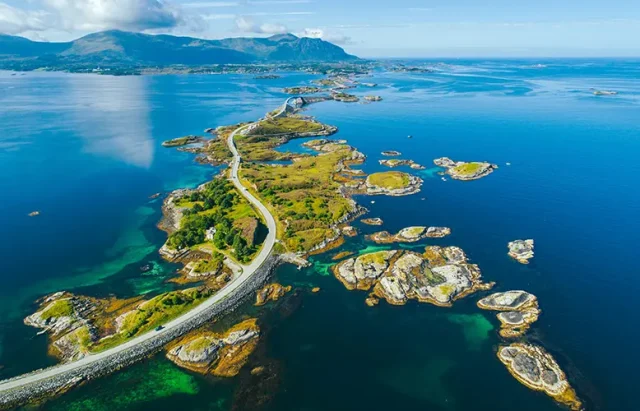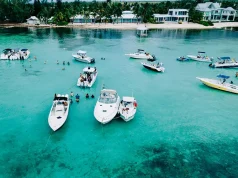
Global searches for “where to road trip” have soared to their highest volume on record this summer, having shot up 113% since the end of 2022, according to Google Trends.
What’s more, searches for “long distance driving” have also skyrocketed to one of their highest recorded figures, sitting 146% higher than the same period of 2005.
With so many searching for the top places to hit the road on holiday, experts at Grand Prix Grand Tours have revealed the best long-distance routes in Europe.
Simon Mawdsley, co-founder of Grand Prix Grand Tours, says: “The price of flights has spiralled this year, with staff shortages and increased popularity resulting in airlines struggling to meet demand. Figures are even showing a rise of as much as 50% to certain destinations. Considering these prices, it comes as no surprise that many are turning towards driving as a way to see the world right now.
“Along with sparing you the trouble of having to fork out on inflated airfares, exploring destinations on four wheels also gives you the freedom to discover places at your own pace and the flexibility to investigate little-known gems along the way.”
The company offers premium driving experiences and packages on a global scale and has become very well acquainted with the most extraordinary roads on the planet.
The 5 Best Long-Distance Driving Routes in the World
- Faroe Islands
The Faroe Islands are incredible to explore on four wheels. The breathtaking archipelago is located between Iceland and Norway and comprises 18 rocky, volcanic land masses in the North Atlantic Ocean.
The remote islets are connected by undersea tunnels, ferries, causeways, bridges and one of the only underwater rotaries in the world. With such advanced infrastructure interlinking the landmasses, your vehicle can seamlessly island hop to all the different landmasses.
Your trip will begin on Vágar, where the airport is located. From here, you can make your way to Torshavn, Streymoy, Gjógv, Viðareiði and Suðuroy. On your adventure, you will come across coastal cliffs, sea villages, fjords, waterfalls and mountain passages.
Along with the isolated and untamed landscape, you are also likely to encounter fascinating wildlife during your journey including clusters of puffins, dolphins and killer whales.
The Faroe Islands encompass a total land area of 1,399 square kilometres. A thorough road trip of Vágar and Streymoy can be comfortably enjoyed in 4 days. However, those looking to uncover more of the archipelago should leave aside a week or longer.
- Romania’s Transalpina
The Transalpina is the highest paved road in the whole of Romania. So, you can expect to be treated to breathtaking vistas around every turn on this route. The road takes you through the Carpathian Mountains, a lesser-known range where nature reigns free.
Picture narrow lanes winding along verdant mountains, passing by naturally-sculpted statues, fragrant meadows, tranquil lakes and cascading waterfalls. Driving the Transalpina typically requires a minimum of 4 hours.
However, the route’s carrying elevations, lack of safety barriers, hairpin bends and active wildlife residents often make it take around 6 hours to complete.
In saying that, we would recommend leaving yourself more time to explore the area. You can stay at traditional hotels in the little villages along the Transalpina. This will give you the opportunity to sample sarmale cabbage rolls or mămăligă polenta in the nearby restaurants.
Additionally, you will also want to leave yourself time to explore the Carpathian mountains on foot. The Transalpina opens in late spring and remains accessible until late Autumn.
- Austria’s Grossglockner High Alpine Road
The legendary Grossglockner High Alpine Road is one of the most beautiful routes in the world. The serpentine circuit guides you on a 48-kilometre journey through the Austrian Alps to the base of Glossgnocker, the country’s highest mountain.
The spectacular peak lies at the centre of Hohe Tauern National Park. Along the way, you’ll venture through verdant mountain pastures, flower meadows and pristine lakes before reaching the highlight of the route: the black mountain of Grossglockner.
The 2,504-metre peak is the highest in the Alpine Republic and towers over the surrounding landscape. During your road trip, you can stop for hikes and visit Edelweiss-Spitze, the highest vantage point along the route.
You should also take some time to visit Nassfeld Speicher, a breathtaking small lake fed by two waterfalls. The Grossglockner High Alpine Road is open from early May until the beginning of November and can be completed in around 2 hours.
- Dingle Peninsula, Ireland
The Dingle Peninsula is easily one of the most beautiful driving routes in the world. Located within the legendary territory of the Wild Atlantic Way, these winding roads offer travellers the chance to uncover Ireland’s famously rugged coastline in all of its glory.
You will want to leave at least a full day to complete the peninsula. Doing so will give you time to explore all of the charming towns located along the way including Dingle, Killarney and Tralee.
The roads themselves are rather narrow and the wind can get quite strong. Conor Pass, for example, is one of Ireland’s highest mountain passes and is single-lane and often cloud-covered.
One of the most beautiful areas of the Dingle Peninsula is Slea Head Drive. The circular route starts at Dingle Town and promises breathtaking panoramic vistas of the Atlantic Ocean, nearby islands, and rugged cliffs. It also takes you through Gaeltacht areas where the Irish language is still spoken, immersing you in traditional local culture while you explore the landscape.
- Atlantic Road, Norway
Norway’s Atlantic Road is one of Europe’s most impressive driving routes. A masterpiece of modern engineering, its eight bridges snake across a wild coastal landscape, connecting islets and islands over a series of causeways, viaducts and bridges.
Your car will cruise above the water’s edge, crossing remarkable bridges suspended over the expansive ocean. The Atlantic Road stretches a distance of over 8274 metres and seamlessly links the cities of Kristiansund and Molde, along with the island of Averøy to the mainland.
You’ll be treated to awe-inspiring scenery along the way. One of the best views along the route is to be found up the soaring path in Eldhusøy. It floats over the terrain, providing panoramic views of the surrounding landscape.
Driving the Atlantic Road also promises bountiful opportunities for cycling and hiking. There is a great variety of accommodation options located by the route that can offer great bases for those wanting to explore the area. The Atlantic Road can be completed in 3 hours but we would recommend dedicating several days to uncovering the incredible beauty and under-explored gems along the route.





